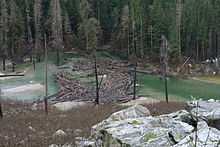Log jam
A log jam is an accumulation of large woody debris (logs more than four inches in diameter and over six feet long) that can span an entire stream or river channel.
Historically in North America, a problematic log jam has sometimes been called a "raft."
Effects on stream/river geomorphology

Log jams alter flow hydraulics, which control characteristics of scour and deposition. Thus, log jams become an important factor in the geomorphology of wooded streams and rivers.
Water is often impounded on the upstream side of a log jam, creating a pool. Water draining from this pool often creates a downstream "plunge pool". Decrease in water velocity in the pool often results in deposition of sand or gravel in the pool bottom. This may progress into "bar" formation.
Log jams also cause shifts in the stream flow. They often redirect flow into former channels or spur creation of new channels.
Effects on ecology
Log jams provide important fish habitat. The pools created and sediment deposited by formation of log jams create prime spawning grounds for many species of salmon. These pools also provide refuge for fish during low water levels when other parts of a stream may be nearly dry. Log jams can provide refuge, as velocity shelters, during high-flow periods.
Pool and bar formation by log jams also provides prime habitat for riparian forests.
The first ecological studies related to log jams were made at Andrews Forest in Oregon.
See also
- Beaver dam, a wooden dam created by beavers
- Great Raft
- River morphology
- Stream restoration
References
- Timothy B. Abbe, David R. Montgomery (1998). "Large Woody Debris Jams, Channel Hydraulics and Habitat Formation in Large Rivers." Regulated Rivers: Research and Management: Vol. 12, No. 2-3, pp. 201–221.
- Connecticut Department of Environmental Protection. Hartford, CT. "Large Woody Debris Fact Sheet." 2007.
- Montgomery, David. King of Fish: The Thousand-Year Run of Salmon. Boulder, CO: Westerview Press, 2003. pp. 205–207.
- Mattole Restoration Council. Petrolia, CA. "Log Jams: How to Determine Appropriateness of Use." MRC Sedment Series Issue #9. 2004.